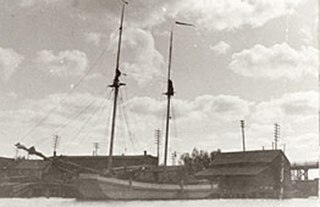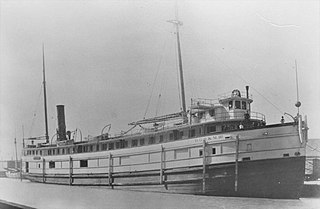
Lake Michigan is one of the five Great Lakes of North America. It is the second-largest of the Great Lakes by volume and the third-largest by surface area, after Lake Superior and Lake Huron. To the east, its basin is conjoined with that of Lake Huron through the 3+1⁄2-mile (5.6-kilometer) wide, 295-foot deep Straits of Mackinac, giving it the same surface elevation as its easterly counterpart; the two are geologically a single lake.

Sheboygan is a city in and the county seat of Sheboygan County, Wisconsin, United States. The population was 49,929 at the 2020 census. It is the principal city of the Sheboygan, Wisconsin Metropolitan Statistical Area, which has a population of 118,034. The city is located on the western shore of Lake Michigan at the mouth of the Sheboygan River, about 50 miles north of Milwaukee and 64 mi (103 km) south of Green Bay.

The Rouse Simmons was a three-masted schooner famous for having sunk in a violent storm on Lake Michigan in 1912. The ship was bound for Chicago with a cargo of Christmas trees when it foundered off Two Rivers, Wisconsin, killing all on board.

The Tennie and Laura was a 73-foot scow-schooner built in 1876 by Gunder Jorgenson in Manitowoc, Wisconsin. It was used as a freighter from the time it was built until the time it sank.
Waubuno was a side-wheel paddle steamer that conveyed passengers and freight between Collingwood and Parry Sound in the 1860s and 1870s. She sank with all hands during a gale on November 22, 1879, though the exact cause of her sinking is unknown.

Algoma was a screw steamer built in 1883. She sank off Mott Island near Isle Royale in Lake Superior in 1885 and some of her remains are still on the lake bottom. The wreck was placed on the National Register of Historic Places in 1984.

The Wisconsin was an iron-hulled package steamer built in 1881 that sank in 1929 in Lake Michigan off the coast of Kenosha, Wisconsin, United States. In 2009 the shipwreck site was added to the National Register of Historic Places.

Hetty Taylor was a schooner that sank in Lake Michigan off Sheboygan, Wisconsin, United States. In 2005 the shipwreck site was added to the National Register of Historic Places. It was included within the boundaries of the Wisconsin Shipwreck Coast National Marine Sanctuary in 2021.

The Phoenix was a steamship that burned on Lake Michigan on 21 November 1847, with the loss of at least 190 but perhaps as many as 250 lives. The loss of life made this disaster, in terms of loss of life from the sinking of a single vessel, the fourth-worst tragedy in the history of the Great Lakes.

SS Choctaw was a steel-hulled American freighter in service between 1892 and 1915, on the Great Lakes of North America. She was a so-called monitor vessel, containing elements of traditional lake freighters and the whaleback ships designed by Alexander McDougall. Choctaw was built in 1892 by the Cleveland Shipbuilding Company in Cleveland, Ohio, and was originally owned by the Lake Superior Iron Company. She was sold to the Cleveland-Cliffs Iron Company in 1894 and spent the rest of her working life with it. On her regular route between Detroit, Escanaba, Marquette, and Cleveland, she carried iron ore downbound, and coal upbound.

Australasia was a wooden-hulled American Great Lakes freighter that served on the Great Lakes of North America between her construction in 1884 to her burning and sinking in 1896. On October 18, 1896, while loaded with coal, the Australasia sank in Lake Michigan near the town of Sevastopol, Door County, Wisconsin, United States, after burning off Cana Island. On July 3, 2013, the wreck of the Australasia was added to the National Register of Historic Places.

Antelope was a Great Lakes steamship that later was converted into a schooner barge) and sank in Lake Superior near the Apostle Islands in 1897.

The SS Atlanta was a wooden hulled Great Lakes steamer that sank in Lake Michigan off the coast of Cedar Grove, Wisconsin, United States, after a failed attempt of her being towed to shore ultimately killing 5 out of her 7 crew members on board. Her wreckage still remains at the bottom of the lake, and on November 6, 2017, the wreck of the Atlanta was listed on the National Register of Historic Places.

The SS J.M. Allmendinger was a wooden-hulled steam barge built in 1883, that ran aground during a storm on November 26, 1895, on Lake Michigan, off the coast of Mequon, Ozaukee County, Wisconsin, United States. On October 11, 2018, the remains of J.M. Allmendinger were listed on the National Register of Historic Places.

SS Pere Marquette 18 was a steel-hulled Great Lakes train ferry that served on Lake Michigan from her construction in 1902 to her sinking in 1910.

SS Vernon was a wooden-hulled American passenger and package freighter that sank in a Lake Michigan storm on October 29, 1887, near Two Rivers, Wisconsin, with the loss of between 36 and 50 lives, making her one of the deadliest shipwrecks ever to have occurred in Wisconsin. Only one of the people on board survived.

SS John V. Moran was a wooden-hulled American package freighter in service between 1888 and 1899. She was built in 1888 in West Bay City, Michigan, by F.W. Wheeler & Company. She was built for Ward's Crescent Transportation Company of Detroit, Michigan, and was operated as part of his Detroit & Lake Superior Line. She was built to haul both bulk, and package freight. Throughout the 1893 shipping season, John V. Moran ran between Buffalo, New York, and Duluth, Minnesota. She was sold for the first time in 1895 to the Union Transit Line of Buffalo, and once again in 1898 to the Crosby Transportation Company of Milwaukee, Wisconsin.

Robert C. Pringle, originally named Chequamegon, was a wooden-hulled American tugboat that sank without loss of life on Lake Michigan, near Sheboygan, Wisconsin, on June 19, 1922, after striking an obstruction.

PS Keystone State was a wooden-hulled American paddle steamer in service between 1849 and 1861. She was built in 1848 in Buffalo, New York, by Bidwell & Banta for ship-owner Charles M. Reed of Erie, Pennsylvania, and operated as part of his "Chicago Line". A luxuriously furnished palace steamer, she operated between Buffalo and Chicago, Illinois, while also making stops at various other ports. She was built for the passenger and package freight trade, frequently carrying both wealthy passengers and European immigrants who desired to settle in the Midwestern United States. Due to the Panic of 1857, Keystone State and several other paddle steamers were laid up. When the American Civil War began in 1861; she was refurbished, and put back into service.


















